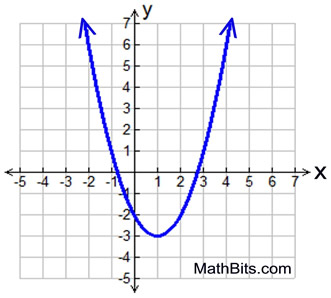

The first activity, Maximum volume of cuboid, is appropriate to this topic and requires students to plot the graph showing the surface area of a cuboid which is then used to find the minimum surface area as the dimensions of the cuboid changes. The activity sheet contains three activities which use graphs of functions in context. Explore Move the a, b and c slider bars to explore the properties of the quadratic graph. Then read more about the Quadratic Equation. Also see the 'roots' (the solutions to the equation). The third section progresses to explore graphs of cubic and reciprocal functions. A Quadratic Equation ( a, b, and c can have any value, except that a cant be 0.) Try changing a, b and c to see what the graph looks like. The examples then move on to explain how the graph of y=x^2 can be plotted by constructing a table of values for x and y which satisfy the equation.
#QUADRATIC GRAPH HOW TO#
The section begins with a recap of how to plot the graph of a straight line by plotting three coordinates which satisfy the equation of the straight line. The vertex here is the origin, (0, 0) and the axis of symmetry is x 0. Standard quadratic graph, Aishah Amri - StudySmarter Originals. The graph of the basic quadratic function is f(x) x 2. If a is positive, the parabola opens upward. We can apply this concept in graphing quadratic equations by altering the coefficients or constants in a given expression. The second section is appropriate to this topic. Sketching Graphs of Quadratic Functions Parabola: graph of quadratic function in the standard form f(x)ax2+bx+c. The text begins with a section explaining linear inequalities. (Note: students will likely need to experiment quite a bit to find an equation that satisfies these constraints.Quality Assured Category: Mathematics Publisher: Centre for Innovation in Mathematics Teaching The following go through the points $(-4,2)$ and $(1, 2)$:

The following have $x$-intercepts at the origin and $(-4,0)$: The following have a $y$-intercept of $(0,-6)$ : The graph of the quadratic function is in the form of a parabola. The following have a vertex at $(-2,-5)$ : The standard form of the quadratic function is f (x) ax 2 +bx+c where a 0. Asking students for three possible answers is a great extension for students - it gets them thinking about the effects of the different parts of the equation. We’re including three possible answers for each one, to demonstrate the type of variability you might expect to see in a class. A quadratic graph is produced when you have an equation of the form \ (y ax2 + bx + c\), where \ (b\) and \ (c\) can be zero but \ (a\) cannot be zero. Note: each of these problems has many possible answers. Further on solving and substituting values for x, we can obtain values of y, we can obtain numerous points. We have found 16 NRICH Mathematical resources connected to Quadratic functions and graphs, you may find related items under Coordinates, Functions and. The $x$-intercepts are $(3,0)$ and $(-1, 0)$, which are most visible in $y_1$ since you can find the roots of the polynomial using the zerofactor property and thus the intercepts correspond to the zeros of each factor. Graphing a Quadratic Expressions The graph of the quadratic expression ax 2 + bx + c 0 can be obtained by representing the quadratic expression as a function y ax 2 + bx + c. The $y$-intercept is $(0, -3)$, which is visible as the constant in $y_2$ since the other terms are 0 when you plug in $x = 0$. These are essential for graphing the quadratic function. The vertex is $(1, -4)$ which is most visible in $y_3$ since the vertex occurs at the point where the squared portion is zero. The primary features of a quadratic graph are x and y-intercepts, vertex, and its orientation. We can see that the difference between it and $y_2$ is just 4, so that graph is 4 units below the other one. The fourth function produces a different graph. Similarly, if we multiply out the perfect square and combine like terms in the third equation, we also get the second one: If we multiply the factors given in the first equation, we’ll get the second equation: You can also graph quadratic functions by applying transformations to the graph of the parent function f(x) x2. This is because the first three equations are equivalent, and so all produce the same graph.

When you graph these four equations, only two different parabolas are shown.


 0 kommentar(er)
0 kommentar(er)
